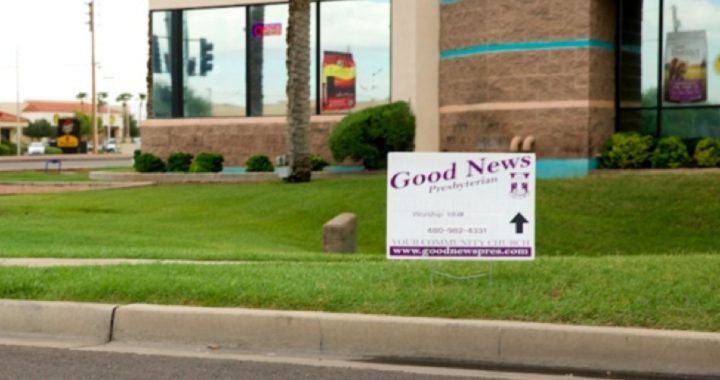
Because his church changes its location fairly often, Pastor Clyde Reed in Gilbert, Arizona, puts up four directional signs for his parishioners to follow in getting to church on Sundays. Under Gilbert’s rule, the signs may not exceed six square feet, may not be placed before 10:00 p.m. Saturday night, and must be removed by noon on Sunday.
However, those wanting to make an ideological statement may put up signs up to 20 square feet in size and leave them up permanently. Those seeking to make a political statement, urging Gilbertians to vote, may have signs up to 32 square feet that are allowed to stay up four and a half months before an election and 15 days afterwards. If a homeowner association wants to announce an event, it’s allowed a sign up to 80 square feet in size for 30 days before the event and 48 hours afterward.
In 2007 Reed sued the city of Gilbert, claiming that its signage discrimination violated his right to free speech guaranteed by the First Amendment. Gilbert officials didn’t relent but instead amended the offending rules to include other non-profit associations in the same restrictions applied to Reed.
Reed appealed and the court ruled in favor of Gilbert, claiming that the city was not intentionally discriminating against Reed or his church, but only allowing directional information to people seeking its location on Sunday mornings.
Reed, with the help of the Alliance Defending Freedom (ADF), appealed to the Ninth Circuit Court, one of the most liberal in the nation, which confirmed Gilbert. It ruled that while the town discriminated against the church, it really didn’t mean to. It declared that there was no intention to harm the church or Pastor Reed, and that the case “lacked a bad motive,” according to the ADF.
[The Ninth Circuit] also agreed with the city of Gilbert’s argument that political and ideological signs are of greater First Amendment value than the church’s religious signs, so [they] may be afforded preferential treatment.
Reed appealed again, this time to the Supreme Court, which decided to hear the case. Arguments are scheduled to begin the second week in January.
The ADF’s case is simple: Gilbert’s signage rules are unconstitutional because they base the size and duration of the signs on their content, and also because Gilbert’s city officials have determined that political and ideological signage is more “valuable” than the church’s religious signs.
As the ADF put it,
A ruling in favor of Good News and Pastor Reed would limit the government’s speech censorship power and affirm the First Amendment’s explicit protection of religious speech.
A ruling in favor of the town [however] would allow government actors broad and arbitrary powers to pick-and-choose what speech it will accord special treatment and what speech it will disfavor and restrict.
A dozen amicus curiae briefs were filed in the case supporting Reed and his church, including one from the American Center for Law and Justice (ACLJ) filed in September. In its summary urging the Supreme Court to take the case, the ACLJ noted:
What is especially infirm about [Gilbert’s] Sign Code challenged here is that it treats various types of noncommercial speech — such as political and ideological expression, and the religious signs of Good News — with different degrees of favorability in terms of size, density and duration.
A month later attorneys for Gilbert responded, saying that Reed and his attorneys were making a mountain out of a molehill; they said the signs provided only directions and nothing more, and therefore were properly restricted. They repeated the same mantra from the Ninth Circuit:
Sign ordinances are necessary to advance legitimate governmental interests such as aesthetics, safety, and [to] maintain property values.
Particularly in the area of sign ordinances, therefore, the content-neutrality test should be applied flexibly with special consideration given to whether the ordinance censors or favors either viewpoints or ideas. (Emphasis added.)
Reed’s attorneys jumped on this as the case was headed higher, pointing out that, if let stand, the Ninth Circuit’s ruling would
give [Gilbert’s officials] the “flexibility” to “balance” the “fundamental right to speak” with the “interests of [their] particular jurisdiction”…
What [the Ninth Circuit’s decision] new test does is give [Gilbert’s officials] license to classify noncommercial speech based on content, which is forbidden by the First Amendment.
It added that this would be unprecedented:
A Political sign that says “Vote Hillary, Register to Vote One Block Down” does not lose constitutional protection because it contains directional content. Nor does an Ideological sign that says “Don’t Waste Your Time on Fairy Tales, Skip Good News’ Services Sunday at Sunrise Senior Living.”
But the same signage for Good News would be ruled unacceptable and prohibited, under Gilbert’s rules, they said.
A graduate of an Ivy League school and a former investment advisor, Bob is a regular contributor to The New American magazine and blogs frequently at www.LightFromTheRight.com, primarily on economics and politics. He can be reached at



